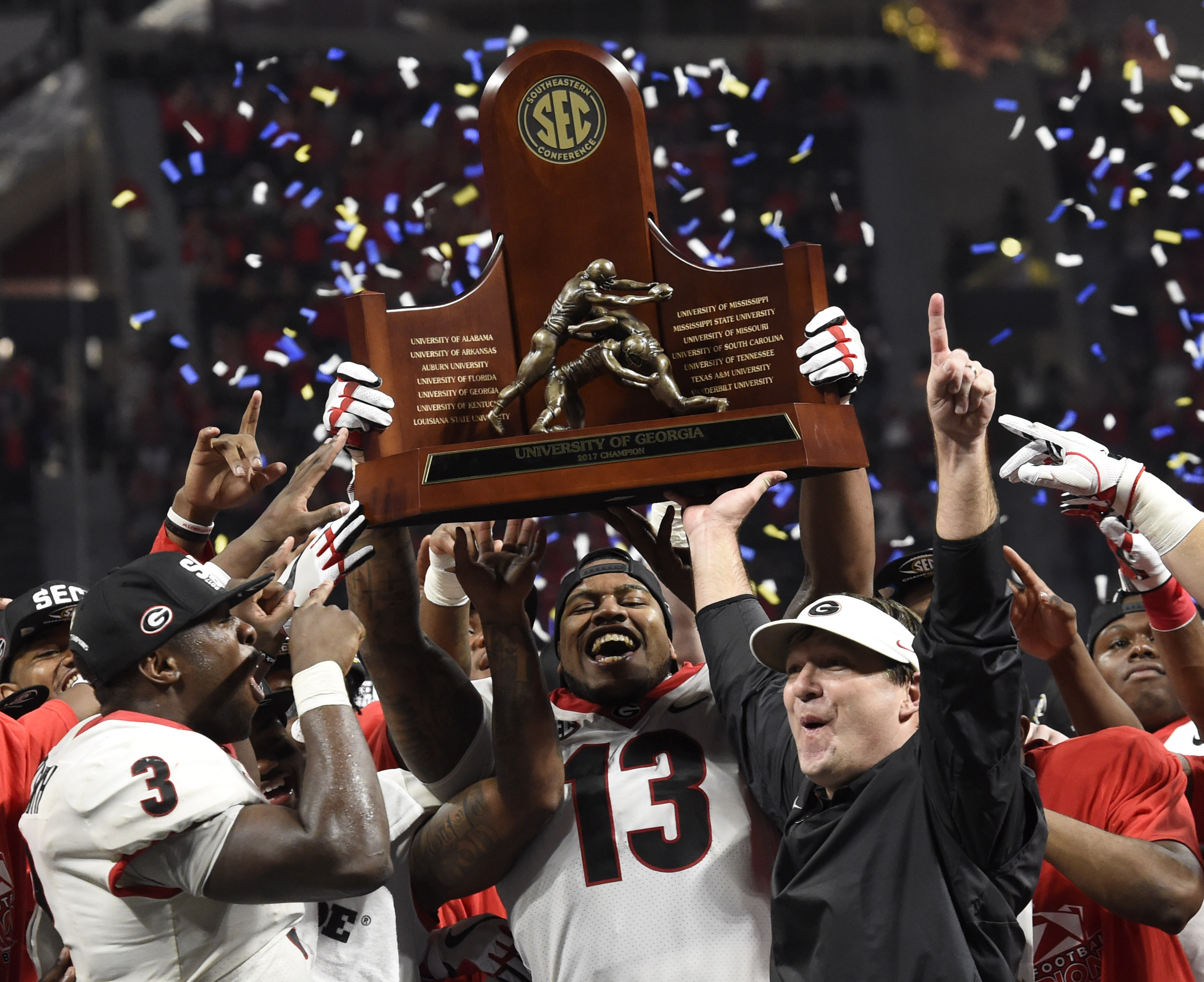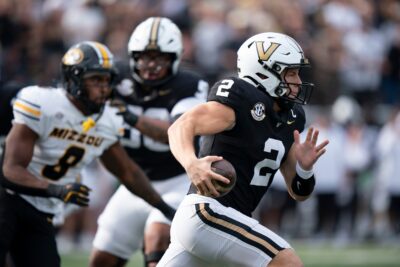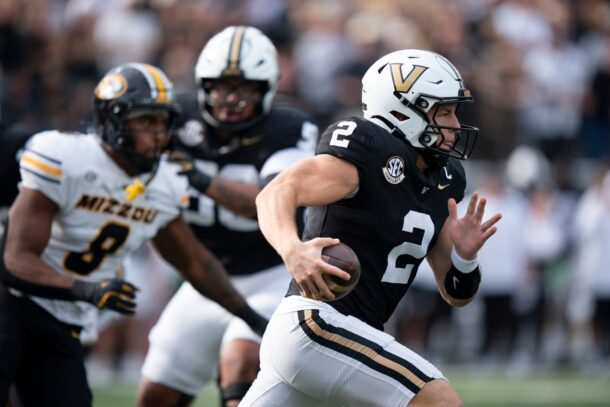
First and 10: Get ready for Playoff expansion. Thanks to SEC, it’s never been closer to reality
By Matt Hayes
Published:
1. I don’t want to get on a soapbox, but …
Two months ago I broke down this very argument, this all too familiar and real possibility that too much SEC in college football could eventually become not enough teams in the College Football Playoff.
Now here we are, at the end of the regular season, staring that reality in the face once again. The overriding question: How quickly can it happen?
Not in 2018, but you better believe any time after that is on the table.
This isn’t so much about inclusion as much as it is keeping the SEC from growing bigger than it already is. The same argument in 2011 that pushed college football away from a BCS postseason, and into a four-team Playoff.
We’re at that precipice again, and the view for college football outside the SEC hasn’t changed: They can’t allow the SEC to once again wide the gap on the field, and more important, in its ability to generate revenue to create a competitive advantage.
It’s nearly an identical dilemma to 2011, when two SEC teams playing in the BCS National Championship Game changed the way the sport ran its postseason. The push to go beyond the last significant change – the BCS to a four-team Playoff – only happens if both Alabama and Georgia win semifinal games and play in the national championship game in Atlanta.
Bill Hancock, executive director of the CFP and mouthpiece for university presidents and conference commissioners who run the show, has said multiple times that the current system is in place for the original 12-year television contract – and that he doesn’t “sense any desire among membership” to move the format past four teams.
But remember, this is the same man who, as executive director of the BCS, staunchly defended that championship game and its quirky formula of selecting two teams until he (see: the university presidents) could no longer.
This isn’t so much about inclusion as much as it is keeping the SEC from growing bigger than it already is.
The most pressing reason to move from the BCS to a four-team Playoff was the growth of the game — and more specifically, the growth of the SEC. The BCS conferences waited too long to stem the emerging power of the SEC, watching it grow from a regional giant into a national behemoth with six consecutive national titles (it would eventually become seven) without taking a stand.
Those national titles were the backbone of what began as Project X in the mind of then-SEC commissioner Mike Slive. It eventually developed into the SEC Network, a cash-generating machine that would only further strengthen the league and widen the gap between it and the other BCS conferences.
Now, fast forward to 2017. For the first time in the brief history of the CFP, two teams from the same conference were selected. Instead of one of the Power 5 conferences being left out of the biggest show in the sport like the previous three years, there are two in 2017 (Big Ten, Pac-12) – the very two that absolutely can’t be left out.

Big Ten commissioner Jim Delany is the most influential power broker in all of amateur sports, and Pac-12 commissioner Larry Scott has been instrumental with innovative ideas to move college sports into new marketing and television horizons, and expand its geographical footprint outside the U.S.
These are two unique power players who won’t sit back and watch the SEC take another huge bite from the apple without fortifying defenses. That means expanding the Playoff.
When change came in 2011, talks initially began as a simple Plus One replacement: one game after all of the bowl games to determine a champion. That idea, fortified during spring and summer of 2011, changed dramatically after the end of the regular season when the BCS formula spit out SEC champion LSU and Alabama – which didn’t win its division or conference – to play in the BCS National Championship Game.
Wouldn’t you know it, Alabama is at the center of it all again. The one-loss Tide were selected to the CFP despite not winning their division (again) and their conference (again), and despite not having near the resume of quality wins compared to Ohio State and USC.
What the Tide had was one less loss, and the now clearly critical eye test metric (more on that later). In fact, CFP committee chairman Kirby Hocutt said Alabama at No. 4 in the final rankings wasn’t really that close.
So now we’re supposed to believe Delany and Scott are going to accept their medicine this fall and not respond? Or as one Big Ten coach texted me after the rankings release:
“Delany won’t take this lying down.”
There’s only one way to go if Alabama and Georgia win their semifinals: Expand the playoff field.
2. Be careful what you wish for
There’s still time to save the four-team format. If one or both of the SEC teams lose in the Playoff, it will stem the growing public perception that four teams isn’t enough.
If both Alabama and Georgia win their semifinals, a wave of public perception will become a tsunami.
The question then becomes, how many teams? Forget about 24 teams like the current FCS format. That’s too many weeks and will be too many games for university presidents – and will eliminate the conference championship games.
The SEC, everyone, will never – let me underscore this, NEVER – get rid of its championship game. It is part of the fabric of the league; it is who they are (and, yes, when the television deal is up with CBS in 2023, look for the SEC to sell its championship game as a stand alone event).
Going to six or eight teams in the CFP doesn’t dramatically change the time frame because you’re using three weeks to complete the Playoff in either scenario. Moving to eight likely hurts the regular season by eliminating at least half of the spots from contention, thus negating the very thing (an engaging and important regular season) university presidents believe they have over every other sport.
If eight teams were used this season, Clemson, Georgia, Wisconsin and Oklahoma could all have lost championship games and still made the Playoff, while Alabama and Penn State could not have played on championship weekend and have potentially earned their way in.

A six-team Playoff would allow for two first-round byes, which could actually heighten the regular season to secure those two precious byes. If a six-team format were used this season, Clemson and Oklahoma would have earned byes, and Georgia-Wisconsin and Ohio State-Alabama would be the quarterfinals.
A six-team format could be used within the current New Year’s Day Six bowl structure, or the quarterfinal games could be played on campus – another way to heighten the regular season.
If you move to an eight-team Playoff, the possibility of more conference dominance arrives. If an eight-team format were used this season, nearly half of the eight teams (Georgia, Alabama, Auburn) would be from the SEC. That, of course, would not go over well – and might just lead to more bracket creep in the following years.
3. Expanding the Playoff, The Epilogue
A more disturbing revelation from this year’s CFP selections: the eye test has become the most important metric in three of the four selection seasons (2014, 2016, 2017).
There’s no tangible formula, just a straightforward metric. The eyes, it seems, have it.
In other words, the CFP is just like the old BCS, based purely on individual opinion over any real metric – only fewer voters with a greater impact on the game. Ohio State won the beauty pageant last year, despite losing to Penn State and Penn State winning the Big Ten Championship.
But Ohio State had one loss, and Penn State had two – and that discrepancy gave cover to the committee’s eye test (see: 2017, Alabama). Ohio State also won the eye test in 2014, when both Baylor and TCU had better tangible metrics, but the Buckeyes earned the fourth spot – and then won the national title, further strengthening the committee’s perceived value.
I’ve said this before and will say it over and over: If you want to truly take any semblance of bias from the CFP decision-making process, televise the committee meetings.
It would be a reality television bonanza, and would be more popular, in some cases, than the games themselves. Since that has no chance of happening (who in their right mind would agree to be on the committee knowing every move they make is going to be wildly scrutinized by both sides of the argument?), we’re left with figuring out how the committee in the past two years has decided that their eye test is more important than winning a championship.
It happened last season with Ohio State, and in a scenario absolutely rich with irony, the CFP chose Alabama over Ohio State for this year’s playoff – and Mr. and Mrs. Ohio State can’t get over it.
The only solution: Expand the field.
4. Public vs. private discontent
Jimbo Fisher will do big things at Texas A&M, finally awakening to sleeping giant in College Station of big things off the field and little production on it.
No one has better facilities than Texas A&M. Not at any college, and not a majority of the NFL franchises. The financial support is endless, the fan support is rabid.
These are only some of the reasons Fisher left a Top 5 gig at Florida State to try and build Texas A&M into a Top 5 job. He hinted at another during Monday’s introductory press conference.
“You can have the greatest coaches in the world, but of the administration doesn’t see things in the way you see things, and allow you to do things that way, nothing can be achieved,” Fisher said.
FSU gave Fisher everything he needed to compete at the highest level. Facilities upgrades, expanded recruiting budget, student athlete support and a salary among the game’s best. But a source close to Fisher told me there has been pressure on Fisher for the past two seasons to make changes within his coaching staff.
He is fiercely loyal to his assistants – to a fault, it can be argued – and didn’t want to make changes after the 2016 season, and only wanted to make changes he felt necessary after both last and this season. Texas A&M then offered a lucrative opportunity with complete autonomy, and Fisher couldn’t say no.
Moreover, every coach has an ego. Every coach believes they can win at any place given full administrative support.
The Aggies are desperate to elevate average on-field performance (25-23 in SEC games, 15-19 in last 34 SEC games) to the level of support off it ($500 million in recent facilities renovations). It’s a seemingly perfect fit.
For now, anyway.
5. The Weekly Five
The picks portion of The Weekly Five returns in two weeks. This week’s Weekly Five: the top five SEC NFL Draft prospects (including potential early entry selections).
- 1. QB Drew Lock, Missouri
- 2. S Minkah Fitzpatrick, Alabama
- 3. LB Roquan Smith, Georgia
- 4. OT Martinas Rankin, Mississippi State
- 5. CB Carlton Davis, Auburn
6. Dodging the obvious
Let’s all pause and applaud the Texas A&M publicity machine for its ability to see potential issues and quash them before they ever grow. That’s what public relation folks are for, right?
But this one was a beaut.

When the Aggies officially announced Fisher as head coach, the first paragraph of the release disclosed Fisher’s $75 million contract and ended any potential argument with this straightforward and unarguable truth: “No state-appropriated funds will be used to pay the coach’s salary.”
See what Texas A&M did there? Fisher’s guaranteed salary – no matter what happens on the field, that entire amount is his – cannot be connected to the growing momentum of pay for play.
Because the obvious question lingering from that guaranteed salary is this: If the Aggies can pay $75 million for a coach, why are players still getting a measly $5,000 stipend for full cost of attendance?
What Texas A&M did with that specific release is clarify that, yes, it has deep-pocket boosters willing to not only buy out Kevin Sumlin’s contract ($10.4 million within 60 days of firing him), but guarantee Fisher earns the largest salary deal (over years) in college football history.
Nowhere in any pay for play argument is there a stipulation that a university’s boosters should be the revenue stream for players earning money to compete. Texas A&M found away to avoid the criticism of paying coaches (fired and hired) but not a players by simply telling the truth.
You may not like what it means, but there’s no debating it.
7. Dawg-gone
Lost in the locker room celebration Saturday night in Mercedes Benz Stadium was the future of former staring Georgia QB Jacob Eason.
Eason wouldn’t specifically comment on his future Georgia, saying only, “I’m taking it day by day; I’m a Bulldog now.”
The reality is, what else can he say? Georgia is in the middle of a national championship run, and even though freshman Jake Fromm is clearly the team’s quarterback of the present and future, Eason can’t make any bold declarations (see: he’s transferring) until after the season.
A Fromm injury would move Eason into the starting lineup in a critical game, and the last thing Georgia needs is controversy around the top backup at the most important position on the field. But there’s little doubt his days at Georgia are coming to an end.
The only question left for Georgia coach Kirby Smart: Can he keep Eason engaged for another month just in case something happens to Fromm, and can he keep committed high school star Justin Fields (more on that below) in the fold?
Eason, who is from Lake Stevens, Wash., is a perfect fit for both of the offenses at Washington and Washington State, and two years ago chose the Bulldogs over Florida and Miami. If he decides to stay in the south – his main reason for leaving Washington and signing with Georgia (and then-coach Mark Richt) was playing in the south and against the nation’s elite – both Florida and Miami would still be a fit.
8. Ask and you shall receive
Hey Matt: I wasn’t too thrilled with the Dan Mullen hire, but it’s growing on me. I like the way he has embraced the program and what we are about. Not like the last guy. How does he succeed following Spurrier and Meyer where the two guys before him couldn’t?
Trent Franklin, Miami
Trent, I know this sounds like a broken record, but it’s all about players. If Mullen can recruit at an elite level (Muschamp did, McElwain didn’t) and develop a quarterback (Muschamp and McElwain didn’t), he can win big there.
I like that Mullen’s first priority was reaching out to committed quarterbacks and seeing if they’re interested in taking a look at Florida. And he’s going after the biggest quarterbacks in the 2018 recruiting class, most notably No.1 recruit Justin Fields, a Georgia commit who chose the Bulldogs over the Gators.
No matter who Mullen lands at quarterback – current Florida commit Matt Corral is still visiting other schools – the current Gators roster is sketchy at the most important position on the field. Feleipe Franks was a train wreck for most of the 2017 season, and the only other scholarship quarterbacks on the roster (rising sophomore Kyle Trask and rising redshirt freshman Jake Allen) have never taken a snap.
Mullen’s track record of developing quarterbacks was the key reason he was hired. Florida has been atrocious offensively and at the quarterback spot, and Mullen’s success at Florida hinges on that position.
9. Numbers game
14: The number of wins for Wake Forest over the past two seasons under Dave Clawson. Why is that significant? Because new Tennessee athletic director Phillip Fulmer is a fan of Clawson, whom he hired away from Richmond in 2008 to coordinate the Vols’ offense.
That was Fulmer’s last season as coach at Tennessee, when he tried to reshape the Tennessee’s pro style offense with Clawson’s spread but wasn’t given more than one season to do so. Clawson’s offenses at Wake Forest inherited a team in 2014 that was 116th in scoring offense (18.3 ppg.) and 120th in total offense (292 ypg.).
Four years later – and back-to-back bowl seasons later – Wake Forest is 32nd in scoring offense (33.7 ppg.) and 29th in total offense (450 ypg.). You want offense, Vols? Clawson is your coach.
10. Quote to note
Georgia linebacker Davin Bellamy on the many sides of coach Kirby Smart: “Kirby only has one side: He rips our ass.”
Matt Hayes is a national college football writer for Saturday Down South. You can hear him daily from 12-3 p.m. on 1010XL in Jacksonville. Follow on Twitter @MattHayesCFB







